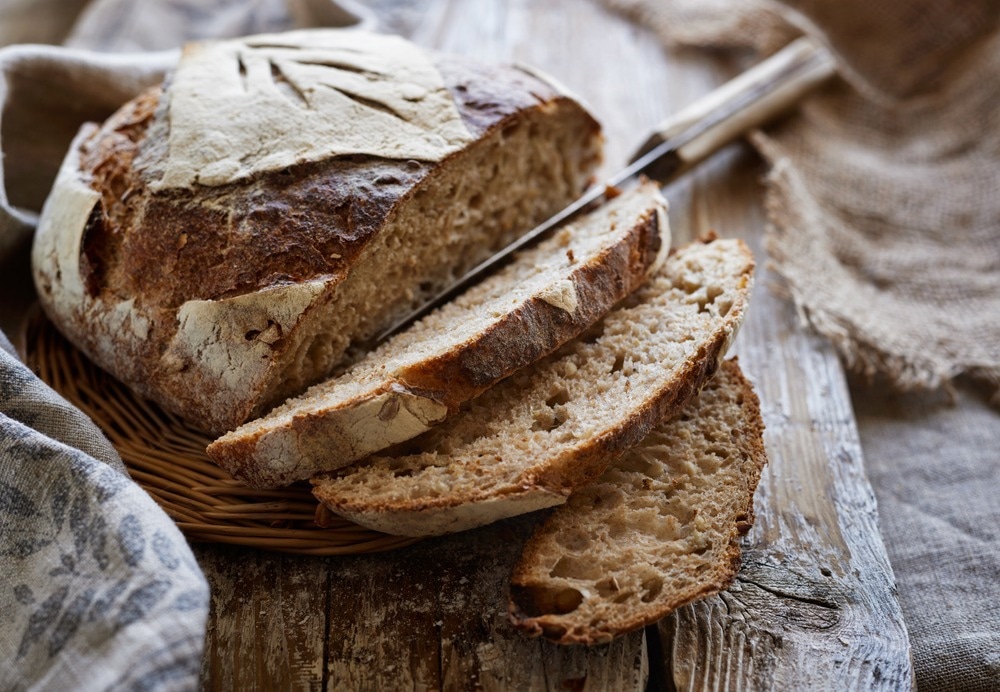A recent investigation into the microbial ecosystem within sourdough has revealed that using various types of flour results in the development of unique bacterial communities. These differences play a crucial role in shaping the diverse aromas and flavors found in sourdough bread.

Image Credit: pbd Studio/Shutterstock.com
People bake sourdough all over the world, and our previous research shed light on the tremendous variation in the types of microbes found in sourdough starters, and how those microbes influence the aroma of sourdough and how quickly it rises.”
Erin McKenney, Study Corresponding Author and Assistant Professor, Applied Ecology, North Carolina State University
Erin McKenney adds, “Our new work focuses on the role that different types of flour play in shaping those microbial ecosystems. As it turns out, the flour bakers use to ‘feed’ their starters plays a significant role in determining which types of bacteria thrive. And that, in turn, strongly influences the aroma that these sourdoughs produce. In other words, our findings show that bakers can influence the aroma of their sourdough by using different flours, because those flours will foster different communities of bacteria.”
In this study, the researchers devised a protocol that aimed to replicate the real-world practices of bakers in their kitchens. They initiated four separate sourdough starters by employing ten different types of flour, resulting in a total of 40 unique starters.
These flours encompassed five with gluten content: unbleached all-purpose flour, red turkey wheat, emmer, rye, and einkorn, and five gluten-free alternatives: teff, millet, sorghum, buckwheat, and amaranth. These 40 starters were nurtured in the same environmental conditions and were provided daily feedings over a span of 14 days.
The research team collected daily data from each of the 40 starters. This data collection involved tracking parameters such as pH levels and the height of the starters. Additionally, the researchers documented the aromas generated by each starter.
To gain further insight into the microbial composition, the researchers extracted samples from the starters for DNA sequencing. This sequencing process allowed them to assess the diversity and abundance of bacteria in each sample.
We found that the starters started out being fairly similar to each other, but that changed substantially over time. Over the course of the 14 days, we found that each type of flour formed increasingly distinct microbial communities. Essentially, it appears that different types of bacteria are able to make the most of the nutritional compounds found in different types of flour.”
Erin McKenney, Study Corresponding Author and Assistant Professor, Applied Ecology, North Carolina State University
When distinct bacterial communities thrive on diverse nutritional inputs, they yield a broad spectrum of metabolic outcomes. In simpler terms, different bacteria are responsible for generating different aromas.
“For example, the bacterial community in amaranth sourdough produces an aroma that smells almost exactly like ham. I’ve never smelled a sourdough that had such a meaty aroma. Rye produces a fruity aroma, buckwheat has an earthy smell, and so on. There’s a tremendous amount of variation,” notes McKenney.
Furthermore, the research uncovered a few unexpected findings.
One surprise was that rye flour fostered a much wider diversity of bacteria than any other type of flour. We found more than 30 types of bacteria in the rye starters at maturity. The next highest was buckwheat, which had 22 types of bacteria. All of the other flours had between three and 14.”
Erin McKenney, Study Corresponding Author and Assistant Professor, Applied Ecology, North Carolina State University
The researchers also noted that seven out of the ten flours led to the development of starters with elevated levels of bacteria that produce acetic acid. Notably, the starters made from teff, amaranth, and buckwheat were exceptions, as they did not contain the acetic acid-producing bacteria.
McKenney notes, “These acetic acid-producing bacteria made up between 12.6% and 45.8% of the bacteria in the starters from those seven flours. So it’s playing a significant role in those microbial ecosystems. This is surprising because we didn’t even know this type of bacteria was found in sourdough until 2020. Our previous work found that it was not uncommon, but to see it at such high levels, across so many types of flour, was definitely interesting.”
While the scientific aspects of this research are undoubtedly intriguing, they also provide valuable practical insights for sourdough bakers.
“This study offers insights into how bakers can modify the flour they’re using in their starters to get the aromas and flavors they’re looking for. We also found that the starters took 10 days to become ‘functionally mature,’ or ready for baking. And that’s useful for bakers to know, too,” concluded McKenney.
Source:
Journal reference:
McKenney, E. A., et al. (2023). Sourdough starters exhibit similar succession patterns but develop flour-specific climax communities. PeerJ. doi.org/10.7717/peerj.16163.